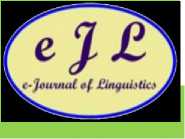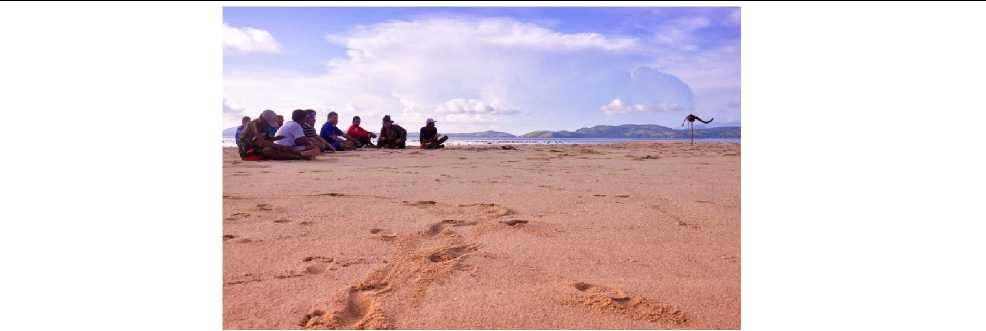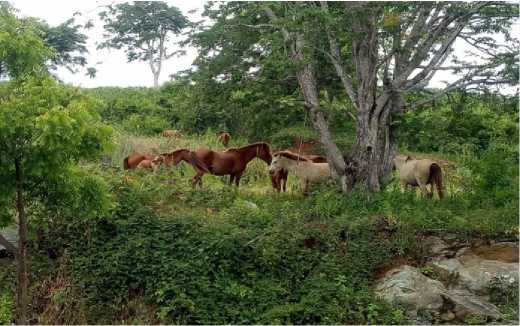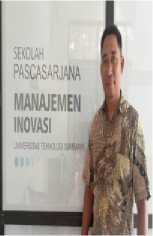The Effectiveness of Eco-Descriptive Text to Increase Student’s English Reading Skill at Senior High School 1 Maronge
on

e-Journal of Linguistics

Available online at https://ojs.unud.ac.id/index.php/eol/index
Vol. 17, No. 2, July 2023, pages: 177--182
Print ISSN: 2541-5514 Online ISSN: 2442-7586
https://doi.org/10.24843/e-jl.2023.v17.i02.p06
The Effectiveness of Eco-Descriptive Text to Increase Student’s English Reading Skill at Senior High School 1 Maronge
1Suparman
Technology of Sumbawa University City, Sumbawa, suparman@uts.ac.id.
2 Hasrul Sani
Technology of Sumbawa University City, Sumbawa, hasrul.sani@uts.ac.id.
Article info
Received Date: 6 February 2023
Accepted Date: 23 February 2023
Published Date: 31 July 2023
Keywords:*
Effectiveness, Eco-Descriptive Tex, English, Reading Skill
Abstract*
This research purposed to find out the student’s reading comprehension by the types of eco-descriptive texts to increase student's English reading skills at senior high school 1 Maronge. The
method of this research of this research applied quasi-experimental research The sampling technique used cluster random sampling technique, which the total sample of this research is 63 students. Data collection techniques used are observation and testing. In addition, the test implemented the pre-test and post-test design. Techniques for analyzing data used descriptive statistical tests and paired sample t-tests. Furthermore, The results of the sample paired t-test showed that the sig. (2-tailed) which is 0.000, the df value is 230, the tcount value is -59.786 which has a positive meaning of 59.786, and the mean value of paired differences is -36.801. So, it can be concluded that sig. (2-tailed) is 0.000 <0.05, and tcount -59.786 > ttable 1.653. This means that there is a significant effect on the use of Eco-Descriptive Text to Increase Students' English Reading through posttest and pretest.
Learning English consists of four skills that must be mastered: listening, speaking writing. and reading. Reading is one of the important skills which not only broadens knowledge but also supports the process of mastering the three other skills. Reading is one of the important aspects of learning English, which is applied at the elementary level until the university level of education. Reading is very important for learners when they are undergoing their education. Then, reading skill is a skill that is difficult for students to master. According to Suryaman, (2012: 37) that the ability to read and write students in Indonesia has not developed optimally, this is based on the results of a UNESCO study through the Program for International Student Assessment (PISA) in 2003, where the reading skills of children in Indonesia aged 15 years and above, is ranked 39th out of 41 countries studied. From the number studied it appears that 37.6% of students could only read, without being able to grasp the meaning, and 24.8% of students could only draw one knowledge conclusion.
The problem in reading comprehension is closely related to word recognition, word meaning, phonetic analysis, and structure. Kodan, (2017) explains that word recognition skills are not developed, and problems arise in reading comprehension. Then, Sitompul (2013) argues that vocabularies or words themselves are one of the success factors for someone in learning a language.
Several studies have implemented various types of strategies and methods (approaches) to improve skills and overcome difficulties in students' reading skills including; Preview, Ask Question, and Summarize (PARS) strategy, Peer-Assisted Learning Strategy, Preview, Question, Read, Summarize, and Test, Using Survey- Question-Read-Review-Recite-Reflect Method, Reciprocal Teaching Method, and Translation Method. Of the various types of strategies and methods (approaches) that are indeed effective for students in certain areas, they cannot accommodate students in other areas, especially students who are in remote and lagging areas.
Therefore, this study tries to examine alternative approaches to improving and overcoming students' difficulties in reading skills. The approach applied in this study is the
ecolinguistic approach. An ecolinguistic approach is an approach that adopts and reads the environment into the classroom. This approach is very effective for multilingual students because this approach can increase cognitive knowledge. This cognitive knowledge has long been embedded in their minds since they began to interact with the environment around them. The environment referred to in this study is in the form of a variety of lexicons sourced from the environment around the students, then designed to be an eco-descriptive text. The role of the environment in the formation of the eco-descriptive text of this research is very important to study, as is the opinion Grabe, (2002) says that reading is defined as an interaction between the reader and the text requiring a rich background and adequate knowledge of the language. This opinion shows that the text produced must be adapted to the student's background.
Some of the earlier studies that have relevance to this research are related to how to increase students' English reading skills. Among them, Barrabas and Setyawa, (2022) researched improving students learning outcomes through reading skills using picture media for elementary school students. Research findings related to observations and assessments of students' reading abilities, in general, they read stories about objects that have been observed based on pictures as learning media in terms of the strengths and weaknesses of these objects. Students observe the objects written in the picture. Students observe the words written in the pictures (Barrabas dan Setyawa, 2022:325). The research discusses improving reading skills, but the research only discusses English teaching media, not covering the material being taught. Furthermore, research conducted by Nurnaningsih (2021) discusses the use of flashcards in teaching English vocabulary to young mothers. The focus of this research findings is the use of flashcards to teach English by changing flashcards in front of the children, then flashcards combined with songs, and lastly flashcards combined with hide-and-seek games (Nurnaningsih, 2021:44). This study emphasizes the use of flashcards to teach English, which has relevance to this research, namely the use of various vocabularies or lexicons to teach English, but the difference lies in the type of lexicon or vocabulary used. In other words, research uses vocabulary related to localization elements to design reading skills materials. Then, Topal, et al,(2019) discusses the effectiveness of smart board media in teaching reading to junior high school student. Then, Topal, et al (2019) emphasizes the use of media in the form of smart boards to teach reading material about the narrative text. So, the location of the difference in this study is in the type of text material used, which this study uses descriptive text material.
Based on the background above, this study examines the effectiveness of eco-descriptive text to increase students' English reading skills at senior high school 1 Maronge. Using the eco-descriptive text is a learning process of interaction between students and learning resources in a learning environment (Pane & Dasopang, 2017). So, the purpose of this research is; (1) to design the types of eco-descriptive texts to increase student's English reading skills at senior high school 1 Maronge, and (2) to analyze the effectiveness of eco-descriptive texts to increase student's English reading skills at senior high school 1 Maronge.
This method of this research applied quasi-experimental research. Creswell (2008: 313) explains that quasi-experimental includes assignment, but not the random assignment of participants to groups. The sampling technique used cluster random sampling technique, which the total sample of this research is 63 students. Data collection techniques used are observation and testing. In addition, the normalized gain analysis was used to assess the improvement of students' learning outcomes (Sudjana, 2016). The test implemented the pre-test and post-test designs. Techniques for analyzing data used descriptive statistical tests and paired sample t-tests.
-
3. Discussions
-
1) . Types of eco-descriptive texts to increase student's English reading skills at senior high school 1 Maronge
The types of eco-descriptive texts to increase students' English reading skills, which are the design from different eco-lexicon. The data of eco-lexicon to design eco-descriptive texts are Marine Beaches Environment, and Fauna in Land Environment. Then, the examples of types of eco-descriptive texts to increase students' English reading skills are as follows.

Figure 1. This is Matti Mindai Beach
Ecodescriptif Text of Matti Mindai Beach
Matti Mindai beach is a beautiful hidden beach with a not long coastline. Matti Mindai beach is approximately one hour from Labuhan Terata village. Matti Mindai beach location is in Gili Dua Rea in front of Ngali island, it is the part of administrative territory Lape district. Visitors come to this beach by a local boat, jukung (local sailing vessel), and sampan.
The reason this beach is called "Matti Mindai" is because Mandar tribe lives in front of the beach and are immigrants from West Sulawesi. "Matti Minddai" is derived from Mandarness and means in Indonesia Language "Timbul Tenggelam"(embossed drowning or ebbtide) beach. "Matti" means tenggelam (drowning or sinking) and "Minndai" means timbul (embossed). It means that this beach will be visible when the sea water is in flux, otherwise, this beach will not be seen when the sea water is refluxed. Matti Mindai beach has a very unique form of sand. The sand on this beach is reddish, it looks star-shaped, and white sand is formed from the remnants of dead sea corals. Furthermore, Matti Minddai beach is flanked by two Gili, namely Gili Dua Kayyang and Gili Dua Cecceng.

Figure 2. This is Jaran (Horse)
Ecodescriptif Text of Jaran (Horse)
Jaran (horse) Samawa is an ungulate mammal or animal that stands on the biggest yoke in its class. The horse stands on one nail so that it is included in the perissodactyl ordo. The horse has ancestral unity with tapirs and rhinos. Horses are one of the most successful modern animals of the genus Equus, due to their ability to survive in natural selection and their ability to evolve very well.
Jaran Samawa belongs to the Eastern horses because it has a small skull shape. This is different from European horses that have large skulls. Seeing the shape of its face, Jaran Samawa is a descendant of horses originating from Mongol, where Mongol horses are thought to be a descendant of the type of Przewalski horse that was discovered in 1879 in central Asia. Jaran Samawa has a body size not too large, and its is height approximately 1.13 meters to 1.33 meters because the Sumbawa region is a tropical climate. Furthermore, Jaran Sumbawa divides into two groups namely Jaran Gamang (a wild horse) and Jaran Main (a racehorse). Jaran Gamang is a horse that is breeding wildly system, whose aim is to fulfill economic needs. Recently, Jaran Gamang develops into a very famous Sumbawa product called Susu Jaran Gamang (wild horse
milk). Whereas Jaran Main is a horse used for folk games known as the Barapan Jaran, which is held annually at the Moyo Festival. In addition, Jaran Samawa is also divided into three based on its age, namely Jaran Nara, Jara Nalu, and Jaran Numpu.
Penerapan teori ekolinguistik pada ecodescriptif text of ecodescriptif text of Jaran (Horse) merujuk pada jenis teks deskriptif tentang unsur lingkungan fauna di daratan. Ecodescriptif text of Jaran (Horse) memiliki kedudukan sebagai proses asimilasi, dan dijadikan sebagai bagian judul teks deskriptif. Kemudian, Ecodescriptif text of Jaran (Horse) dijelaskan pada paragraf pertama termasuk pada proses asimilasi yang membentuk bagian part of identification dari teks deskriptif. Bagian identifikasi terdapat pada kalimat Jaran Samawa is belong to the Eastern horses, because it has a small skull shape dan seterusnya.
Data ekoleksikon yang berkedudukan sebagai proses akomodasi dalam pengembangan teks deskrtiptif menggunakan ekoleksikon Matti Mindai beach. Data ekoleksikon yang terdapat pada proses akomodasi membentuk part of description (bagian deskripsi) dari teks deskriptif. Hal ini dicantumkan pada paragraf kedua yaitu Jaran Samawa is belong to the Eastern horses, because it has a small skull shape. This is different from European horses that have a large skull. Seeing the shape of its face, Jaran Samawa is a descendant of horses originating from Mongol, where Mongol horses are thought to be a descendant of the type of Przewalski horse that was discovered in 1879 in central Asia. Jaran Samawa has a body size not too large, and it is height appoximately 1.13 meters to 1.33 meters, because Sumbawa regional is a tropical climate. Furthermore, Jaran Sumbawa divide into two groups namely Jaran Gamang (wild horse) and Jaran Main (race horse). Jaran Gamang is a horse which is breed wildly system, whose aim to fulfill economic needs. Recently, Jaran Gamang develops into a very famous Sumbawa product called Susu Jaran Gamang (wild horse milk). Whereas Jaran Main is a horse used for folk games known as the Barapan Jaran, which is held annually at the Moyo Festival. In addition, Jaran Samawa also divided into three based on its age, namely Jaran Nara, Jara Nalu and Jaran Numpu.
-
2) The effectiveness of eco-descriptive text to increase student's English reading skills at senior high school 1 Maronge
The results of the analysis to measure the effectiveness of eco-descriptive text to increase student's English reading skills at senior high school 1 Maronge is something that must be done, because the results of the effectiveness test form the basis that the eco-descriptive text material that has been developed has a significant impact on change. achievement of student learning. The results of the effectiveness test are carried out by giving a test in the form of an eco-descriptive text and accompanied by questions from the text.
The tests given to students in this study consisted of an initial test (pretest) and a final test (posttest). The purpose of the pretest was conducted to determine students' initial ability to understand the type of descriptive text that had been developed. The final test was conducted to find out how significant the changes in student scores were, after receiving treatment through learning a variety of descriptive texts. The purpose of the final test was carried out to compare the differences in student scores with the scores obtained during the initial test.
Pre-test and post-test were implemented in the form of eco-descriptive text with different topics. Different topics are adapted to the school environment (ecology) of each respondent in this study. Furthermore, the pre-test and post-test questions were designed based on the number of respondents in each research location. Students' pre-test and post-test scores were analyzed using SPSS. Then, a descriptive statistical test was performed, and a paired sample t-test was performed. The results of the analysis of the initial test scores and the final test are as follows. An overview of the results of the pre-test descriptive statistical tests on the eco-descriptive text of Matti Mindai Beach and the post-test on the eco-descriptive text of jaran (horse) is as follows.
Table 1. The result of the Pre-Test and PostTest
|
N |
Lower Score |
Higher Score |
Sum |
Mean |
Std. Deviation | |
|
Pre Test |
231 |
20 |
70 |
11228 |
48.61 |
8.615 |
|
Post Test |
231 |
70 |
100 |
19729 |
85.41 |
7.558 |
|
Valid N | ||||||
|
(listwise) |
231 |
Based on the table. 1 above shows the results of the descriptive statistical test from the post-test scores regarding the eco-descriptive text of horse, it can be seen that the lowest value is 70 and the highest value is 100. Furthermore, the sum is 19729, the mean value is 85.41 with a standard deviation of 7.558. The number of respondents was 231 students. On the other hand, the results of the descriptive statistical test of the pre-test values regarding the eco-descriptive text of Matti Mindai Beach are based on the table. 3 above shows that the lowest score is 20, and the highest score is 70. The mean value in the pretest is 48.61, the sum is 11228, and the standard deviation value is 8.615. Based on the interpretation of the percentage of the mean value of 48.61, it was found that the percentage of achievement of the average (mean) was in the range of 55-64%.
Tabel.2 Hasil Uji Paired T-Test
Paired Differences
|
Me |
95% Confidence Std. Interval of the Sig. Devi Std. Difference (2- atio Error Lowe taile |
|
an |
n Mean r Upper t df d) |
|
Pre - Test- 36. Post 80 test 1 |
_ _ _ -- 9.35 .616 38.01 35.58 59.78 230 .000 6 4 8 6 |
Table. 2 shows the results of the sample paired t-test on the posttest scores regarding the eco-descriptive text of jaran (horse), and the pretest values regarding the eco-descriptive text of matti Mindai Beach. The results of the sample paired t-test showed that the sig. (2-tailed) which is 0.000, the df value is 230, the tcount value is -59.786 which has a positive meaning of 59.786, and the mean value of paired differences is -36.801. So, it can be concluded that sig. (2-tailed) is 0.000 <0.05, and tcount -59.786 > ttable 1.653. This means that there is a significant effect on the use of Eco-Descriptive Text to Increase Students' English Reading through posttest and pretest.
The novelty of this research lies in the approach used, namely the ecolinguistic approach. This approach is used to design a variety of eco-descriptive texts to improve students' English reading skills.
Learning by using an environmental approach as the material used to design eco-descriptive text can help students understand the contents of the descriptive text developed in this research. This can be seen from the changes in the results of the students' pre-test and post-test, where it was found that sig. (2-tailed) is 0.000 <0.05, and tcount -59.786 > ttable 1.653. This means that there is a significant effect on the use of Eco-Descriptive Text to Increase Students' English Reading through posttest and pretest.
The writer would like to thank and appreciate those who have contributed to this current
study, especially the Director of the Master Innovation Program who has contributed to the maximum completion of this study. The English teacher of SMAN 1 Maronge Mr. Safarudin, S.Pd., M.Pd always supports the writer during research in his English class.
References
Barrabas, D & Setyawan, A. (2020). Improving Students Learning Outcomes Through Reading Skills Using Picture Media For Elementary School Students. Maktab: Jurnal Pendidikan dan Teknologi. 1(1), 322-327.
Creswell, J. W. 2008. Educational Research: Planning, Conducting and Evaluating Quantitative and Qualitative Research: Third Edition. New Jersey: Pearson
Education.
Grabe, W. (2002). Foundations for L2 reading instruction. The Language Teacher
Online. Retrieved from http:// www.jalt-publications.org/tlt/articles/20 02/07/grabe.
Kodan, H. (2017). Determination of Reading Levels of Primary School Students.
Universal Journal of Educational Research, 5(11), 1962–1969.
https://doi.org/10.13189/ujer.2017.051112.
Nurnaningsih. The Use of Flashcard In Teaching English Vocabularies by Young Mothers. Surakarta English and Literature Journal. 4 (1), 44-53.
Pane, A., & Dasopang, M. D. (2017). Belajar dan Pembelajaran. FITRAH Jurnal Kajian Ilmu-Ilmu Keislaman, 3(2), 333–352.
Sitompul, E. Y. (2013). Teaching Vocabulary Using Flashcards and Word Lists. Journal of English and Education.
Sudjana, N. (2016). Penilaian Hasil Proses Belajar Mengajar (17th ed.). Rosdikarya.
Suryaman, M. 2012. Metodologi Pembelajaran Bahasa. Yogyakarta: UNY Press.
Topal, H., Fitriani, S.,S. & Erdiana.,N. (2019) The Effectiveness of Smart Board Media in Teaching Reading for Junior High School Students. Research in English and Education (READ). 4(3), 108-118.
Biography of Authors


Suparman was born in the Lab. Terata, October 7, 1987. He is a lecturer in English at the Higher School of Teacher Training and Education of Paracendekia NW Sumbawa, Indonesia from 2014 until 2022. Nowadays, he is a lecturer in the Master Innovation Program Graduate School of Technology of Sumbawa University. He took his undergraduate education at IKIP Mataram which is now the University of MandalikaMataram (UNDIKMA), majoring in English education. Then, he continued his master's degree at Ahmad Dahlan University, Yogyakarta, majoring in English Education. Currently, he is pursuing his doctoral education at Udayana University, Denpasar. He graduated in 2022, with his doctoral program in the study of linguistic linguistics.
Email: suparman@uts.ac.id.
Hasrul Sani is a lecturer in English at Technology of Sumbawa University. He took his master's degree at Ahmad Dahlan University, Yogyakarta, majoring in English Education. Email: hasrul.sani@uts.ac.id.
Discussion and feedback